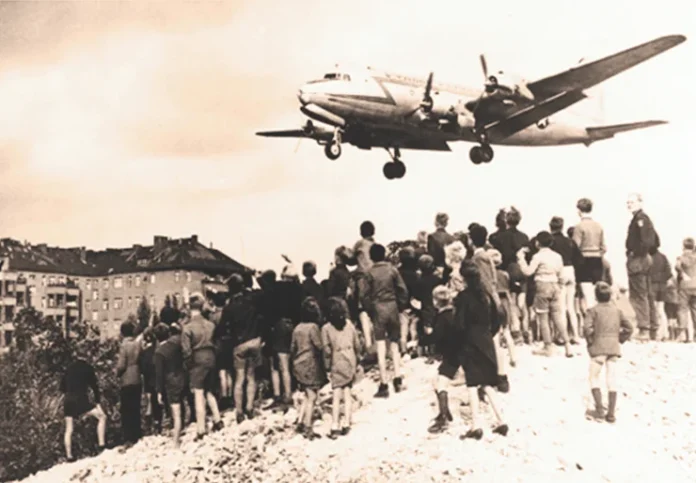Fear of The Union
In 1945 as World War 2 drew curtains, it left countries with massive destruction. More than 35 million dead in Europe alone; those who survived the carnage were forced to live the life of a refugee. The culmination of World War 2 gave birth to a long-drawn Cold War. The Soviets and Americans both fought the common threat of a likely expansion by the other. While the majority of European powers faced decimation by the end of the war, the Soviets luckily survived with a strong military and vast territory. Europe was under tremendous stress to build back, but they continued to fear Soviet intentions.
The actions of the Soviet Union were only further aggravating their insecurity. Overthrowing the elected government in Czechoslovakia by a communist coup in February 1948 and the blockade of East Berlin a few months later were direct actions undertaken by the Soviet Union. These actions created anxiety in Western Europe and the search for a military alliance. Americans, sensing the panic, quickly stepped in with a bounty of assurances and hordes of dollars. They began formulating an alliance that would turn out to be the most prolific military alliance created in peacetime. North Atlantic Treaty Organization or NATO was thus formed in April 1949 with 12 founding members across the Atlantic, which included the Western European powers, USA and Canada.
The most important of the binding force for NATO was Article 5 which unambiguously said – “an attack on one is an attack on all”. The Soviet Union saw this coming after the first two NATO expansions in 1952 & 1955. The Soviet Union formulated its own security alliance as a counter to NATO via the Warsaw Pact. The communist country’s isolationist approach was most fearsome; as if the world constituted of them and more nations like them only.

Balance Shifts
Strangely it was not the US, their bête noire of Cold War, but NATO that placed severe resource challenges on the communist giant. The Soviet Union was under pressure to convince its Eastern European allies that they will implement matching security and resources as their 2 Western European counterparts
During the Golden Age of Capitalism between 1951 – 1973, tremendous economic expansion took place in Europe. The addition of Spain as a new member of NATO in 1982 further gave them psychological strength. The Soviets were not happy about this but nevertheless had to square up. Strangely it was not the US, their bête noire of Cold War, but NATO that placed severe resource challenges on the communist giant. The Soviet Union was under pressure to convince its Eastern European allies that they will implement matching security and resources as their 2. Western European counterparts. This time Soviet intelligence committed a historical error. Their focus shifted too much outward while the threats were emerging closer home. Soviets started spending heavily on their military to counter NATO, which was three times what the US was spending, while its economy was only one-third of that of the US.
It was a leap of no return; the Soviets placed immense stress on their own resources to match their military ambitions, which were clearly unsustainable. It was a subjugating scenario created deliberately, wherein the Soviets got stuck once and till the Union lasted. The agenda was clever, making the adversary weaken under its own weight. What the centuries of conflicts and World Wars could not do, this ingenious trick could.

Emergence Of The Federation
Russia probably crossed its worst phase of history when it witnessed the Union being divided into 15 independent nations. The new Federation weathered bruises of 23% reduced land mass, 82% reduced economic size and unquantified emotional pain. Russia, among other things, faced a critical leadership crisis during this transition when its adversaries didn’t lose an opportunity to heap more embarrassments.
After leaders like Mikhail Gorbachev and Boris Yeltsin, came Vladimir Putin. He was a complete non-conformist of a political leader, an unknown persona even for Russians. No one knew this ex-frontline KGB operative, partially because of his profession and partially as an attribute to his mysterious personality. In reality, this was one of the essential traits of Putin which qualified him for the top job in the first place. Owing to worsening health and a fear of reprisal after leaving office, Boris Yeltsin wanted the next President to be an outsider whom he could trust. An unassuming Vladimir Putin with a complete low profile fitted the bill.
An influential Russian Oligarch propped up Yeltsin to replace an increasingly unpopular Boris Yeltsin on new year’s eve in 1999. A new era had begun; all it was known was that Vladimir Putin is a nationalist, simple but strong-headed individual who doesn’t shy away from unorthodox methods; a lesson probably from his erstwhile profession. He went about rebuilding the Federation with a mission-like focus, although his critics suggest that he strengthened his own position more than that of Russia. He did bring out increased prosperity, economic development, and more importantly, a strong economic integration with the EU.

A Celebrated Alliance?
With an improved economy, President Putin consolidated his position further. Putin’s asset was his deep knowledge of European behaviour learnt during his days of KGB operations. He knew the limitations of NATO. For all its fame, NATO still remains more of a celebrated alliance than military power. Somewhere, he was convinced that the real player and threat to Russia was not from Europe but from across the Atlantic. NATO did much to give this theory credence; not a single of NATO’s military operations was self-driven. The Bosnian war in February 1992, the first NATO military operation in more than four decades of its existence, and the intervention in Libya in March 2011, were both mere enforcements of UN resolutions. After 9/11, the Afghan war was the only occasion where NATO invoked its famed Article 5 for collective security.
How ironic it was, that an organisation primarily created to ensure the collective security of Europe, acted only once on its own, and that too, to collectively safeguard American security! Willy-nilly NATO had landed its feet where the US had wished and not vice-versa. If the sudden and embarrassing withdrawal from Afghanistan in August 2021 is anything to go by, it failed NATO’s mission of leading the ISAF to laid down objectives. Nothing can bring more truism than the reality that– the ‘US has built, sustained and exploited NATO for its own advantage’ and all this at the expense of Europe! All the might and the sustained operations of NATO over the years in Afghanistan could not achieve its mission objectives. Ergo, we need to pause discussions on NATO vs the Russian Federation.
NATO’s achievements, if counted, remained a reactive response to Soviet actions. From its emergence to date, the Soviet Union, or lately the Russian Federation, has spooked NATO not once but multiple times. In the Korean war initiated by North Korea with Soviet backing in June 1950, and the Suez crisis, where there was a credible threat from the Soviet Union, the UK and France, both key NATO members, retreated with humiliation. The Soviet launch of Sputnik had stunned NATO into greater scientific cooperation. In 1962, the failed CIA-sponsored Bay of Pigs invasion immensely damaged US credibility; the Soviet missile deployment in Cuba followed suit. These incidents forced NATO to recalibrate its crisis response from “Massive Retaliation” to “Flexible Response”. The new millennium didn’t turn out any better with the shock annexation of Crimea and now the bold military actions in Ukraine. The Russian Federation has NATO scourging for cover and muddled for a response.

Misplaced Sense of Security
In all these years, NATO has redefined itself on multiple occasions, and as they say – the more it changes, the more it remains the same. It could never feel convinced about its own capacity, the right size, the right priorities or even the right liabilities. Its eight expansions to date and a ninth one in the offing bear testimony to the fact that while its stated adversary Soviet Union reduced in all dimensions and capacity. Primarily, because more than a military strategy, the decision of expansions has been a political one; much of it spurred by the US and sleepwalked by NATO. Any sane military mind would argue to maintain a buffer territory with your prime adversary.
Not with NATO though; on the contrary, NATO continues to headbang right into its adversary’s backyard. Result – reduced thresholds, reduced reaction time, quick provocation and immediate aggravation.
An alliance fabricated to give peace of mind to its original European members has morphed into a critical security dilemma for those member states themselves. The only NATO member to gain all is the one sitting across the Atlantic with no direct borders remotely coming close to Russia. The world still remembers what happened when the only time the US and the Soviet Union came close to an actual skirmish during the Cuban missile crisis.
The credentials of the likely two new NATO members, Finland and Sweden, would suggest that NATO’s active military strength and defence budget of its European allies will increase by merely 1.3% and 3.1%. The corresponding liability to defend territory would have increased by 18%, and the territory which directly borders Russian Federation by 260% – from 508 Km to 1,848 Km. NATO is betting its audacity on a weakened Russia, but it should know history well; where Russia has grudgingly lost territory, it has consolidated its liabilities, whereas NATO continues accumulating new vulnerabilities.
NATO is committing the same mistakes where it had proved one up on the Soviet Union; it is growing into an unsustainable size and racking up too many commitments. There appears a déjà vu; history repeating itself only the protagonist would have interchanged with catastrophic implications for NATO’s minion member states!
–The writer has varied experience in security paradigm and is a keen follower of international geopolitics. He is also the author of popular blog site (geostrat.in) on geo-strategic affairs. The views expressed are personal and do not necessarily reflect the views of Raksha Anirveda
-The writer has varied experience in the security paradigm and is a keen follower of global geopolitics. His work has been regularly featured in national publications. Visit newsanalytics.in to access more articles from the author. The views expressed are of the writer and do not necessarily reflect the views of Raksha Anirveda





